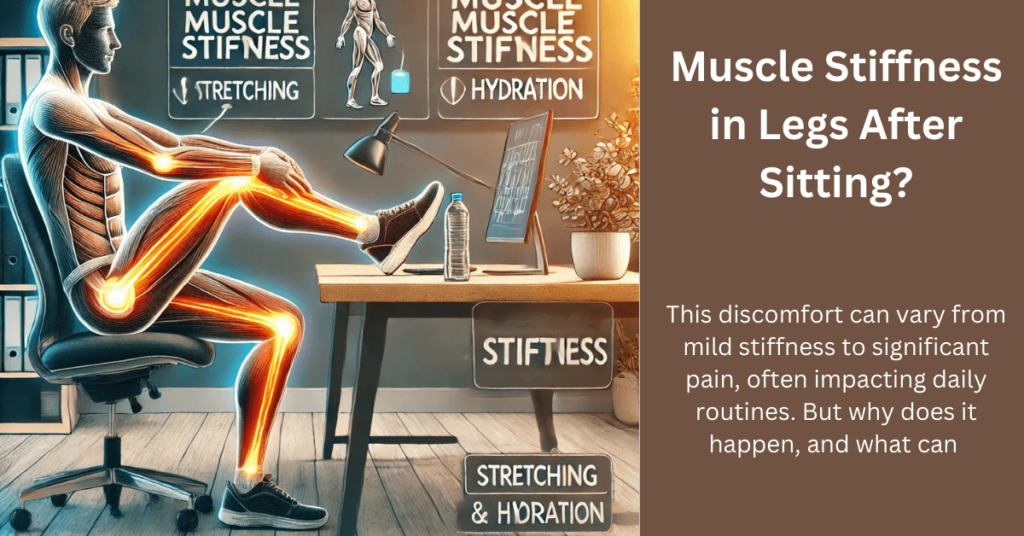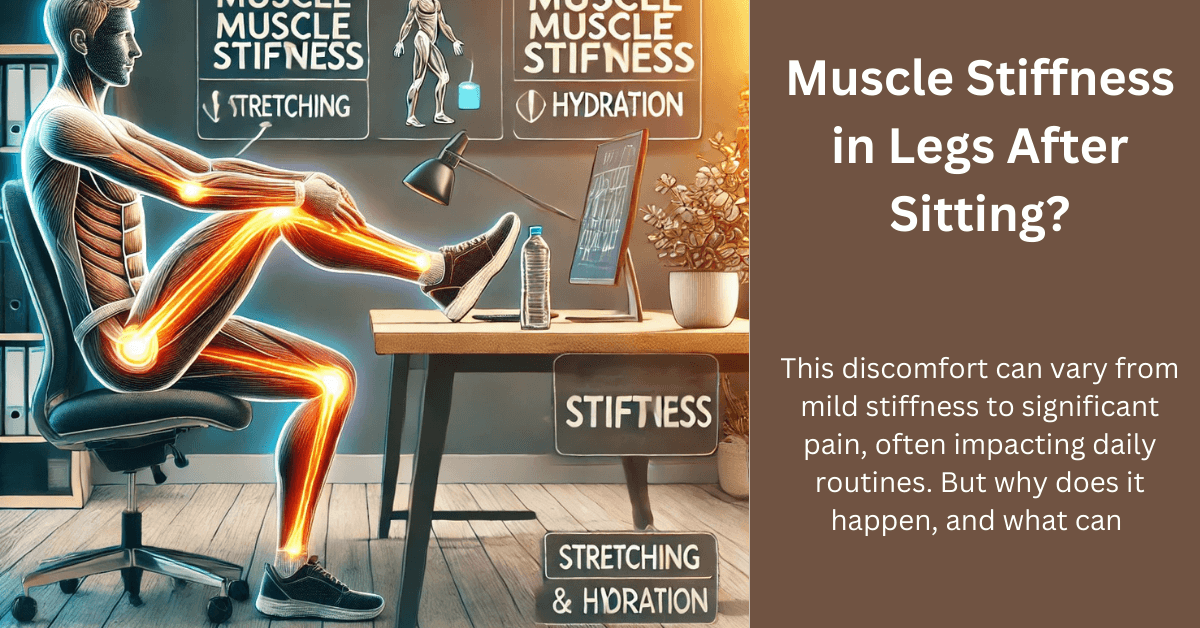Muscle Stiffness in Legs After Sitting? Whydo you Experience it? Muscle stiffness in legs is a common issue for many people, particularly those who lead sedentary lifestyles or work desk jobs. This discomfort can vary from mild stiffness to significant pain, often impacting daily routines. But why does it happen, and what can you do to prevent it?

The Causes of Muscle Stiffness in Legs After Sitting
Understanding the root causes of muscle stiffness in legs after sitting can help in addressing and preventing the problem effectively. Here are some of the primary reasons:
- Prolonged Immobility: When you sit for extended periods, blood circulation slows down, leading to a lack of oxygen and nutrients reaching your muscles. This can result in tightness and discomfort.
- Poor Posture: Sitting with poor posture—such as slouching or crossing your legs—can strain your muscles and joints, exacerbating stiffness in the legs.
- Reduced Flexibility: Over time, prolonged sitting can lead to shortened and tightened muscles, particularly in the hamstrings and hip flexors, which may cause stiffness when you stand up.
- Muscle Weakness: A lack of physical activity can weaken muscles, making them more prone to stiffness after sitting.
- Underlying Health Conditions: Conditions such as arthritis, fibromyalgia, or peripheral artery disease may contribute to recurring muscle stiffness in legs after sitting.
Symptoms of Muscle Stiffness in Legs After Sitting
Muscle stiffness in legs after sitting often presents with the following symptoms:
- Difficulty standing or walking immediately after sitting.
- A feeling of tightness or tension in the muscles.
- Occasional pain or discomfort, especially in the thighs and calves.
- Swelling or a sensation of heaviness in the legs.
If these symptoms persist or worsen, consulting a healthcare professional is advisable to rule out any serious underlying conditions.
How to Prevent Muscle Stiffness in Legs After Sitting
Preventing muscle stiffness in legs after sitting requires proactive measures to promote mobility and flexibility. Here are some effective strategies:
To prevent muscle stiffness in the legs after sitting for long periods, it’s important to maintain good posture and keep your body moving regularly. Avoid sitting in the same position for too long—stand up, stretch, or walk around every 30–60 minutes to promote blood circulation.
Simple stretches like flexing and extending your ankles, rolling your feet, or gently stretching your calves and hamstrings while seated can also help. Keeping your chair at the right height, with feet flat on the floor and knees at a 90-degree angle, reduces strain on the leg muscles.
Staying hydrated and maintaining a diet rich in magnesium, potassium, and calcium supports healthy muscle function. If you sit for work, consider using an ergonomic chair or a footrest to keep muscles relaxed. Regular exercise, such as walking, yoga, or light strength training, also strengthens the muscles and makes them less prone to stiffness.
1. Take Frequent Breaks
Avoid sitting for long periods by taking regular breaks. Stand up, stretch, or walk around every 30 minutes to stimulate blood flow and relieve tension.
2. Maintain Proper Posture
Ensure your chair and desk setup support good posture. Keep your feet flat on the floor, your back straight, and your shoulders relaxed to minimize strain on your muscles.
3. Incorporate Stretching Exercises
Regular stretching can improve flexibility and reduce muscle stiffness. Focus on stretches for the hamstrings, calves, and hip flexors to counteract the effects of sitting.
4. Stay Hydrated
Dehydration can contribute to muscle cramps and stiffness. Drinking enough water throughout the day helps keep your muscles supple and reduces discomfort.
5. Strengthen Your Muscles
Engage in exercises that target your leg muscles, such as squats, lunges, and calf raises. Strengthening these muscles can prevent stiffness and improve overall mobility.
6. Use Ergonomic Furniture
Investing in ergonomic chairs and desks can reduce the strain on your muscles and joints, minimizing the risk of stiffness.
“Using Meditation to Relieve Leg Muscle Stiffness After Sitting”.
Meditation can be a powerful tool to ease muscle stiffness in the legs after sitting by combining relaxation with gentle awareness of the body. Start with deep, slow breathing to calm the nervous system and improve oxygen flow to tense muscles. While seated comfortably, practice a body scan meditation, directing attention to the legs, calves, and feet, noticing sensations without judgment.
This mindful awareness often helps muscles naturally release tension. You can also visualize warmth or light flowing through stiff areas, encouraging relaxation. Pairing meditation with gentle movement, such as mindful stretching or yoga-inspired poses, enhances blood circulation and loosens tight muscles.
Practicing progressive muscle relaxation—tensing the leg muscles for a few seconds and then slowly releasing—can further reduce stiffness. Over time, regular meditation lowers overall stress, which contributes to less muscle tightness. Even 5–10 minutes daily can support both mental calmness and physical ease.
Home Remedies for Muscle Stiffness in Legs After Sitting
If you’re already experiencing muscle stiffness in legs after sitting, these remedies can provide relief:
- Apply Heat or Cold Packs: Use a heating pad to relax tight muscles or a cold pack to reduce inflammation and numb discomfort.
- Massage the Affected Area: Gently massaging your legs can improve circulation and alleviate stiffness.
- Practice Yoga or Pilates: These activities enhance flexibility and strengthen muscles, providing long-term relief from stiffness.
- Take an Epsom Salt Bath: Soaking in warm water with Epsom salt can relax your muscles and reduce tension.
- Try Over-the-Counter Pain Relievers: For persistent discomfort, medications like ibuprofen or acetaminophen can help.
Vegetables for Muscle Stiffness Relief
- Spinach & Kale – High in magnesium and potassium, easing cramping and stiffness.
- Broccoli – Rich in vitamin C and antioxidants that reduce inflammation.
- Beets – Improve blood flow and oxygen delivery to muscles.
- Sweet Potatoes – Packed with potassium and complex carbs for muscle recovery.
- Avocado – Great source of potassium, magnesium, and healthy fats.
- Cucumber – Hydrating and helps flush out toxins.
🍊 Fruits for Muscle Stiffness Relief
- Bananas – One of the best sources of potassium for cramp prevention.
- Oranges & Citrus Fruits – Vitamin C supports collagen and reduces oxidative stress.
- Berries (Blueberries, Strawberries, Cherries) – Anti-inflammatory and rich in antioxidants.
- Pineapple – Contains bromelain, which helps reduce inflammation.
- Watermelon – Hydrating and contains L-citrulline, which relaxes muscles.
- Kiwi – High in vitamin C and potassium for muscle repair.
When to See a Doctor
While occasional muscle stiffness in legs after sitting is normal, persistent or severe symptoms may indicate an underlying health condition. Consult a doctor if you experience:
- Persistent pain that doesn’t improve with home remedies.
- Swelling or redness in the legs.
- Numbness or tingling sensations.
- Difficulty walking or bearing weight on your legs.
Exercises to Combat Muscle Stiffness in Legs After Sitting
Incorporating specific exercises into your routine can significantly reduce muscle stiffness. Here are a few effective ones:
1. Hamstring Stretch
- Sit on the edge of a chair with one leg extended.
- Lean forward gently while keeping your back straight.
- Hold for 20-30 seconds and switch legs.
2. Calf Raises
- Stand with your feet shoulder-width apart.
- Raise your heels off the ground and slowly lower them back down.
- Repeat 10-15 times for better blood flow.
3. Hip Flexor Stretch
- Kneel on one knee and place the other foot in front, forming a 90-degree angle.
- Push your hips forward slightly and hold for 20-30 seconds.
- Switch sides and repeat.
4. Leg Swings
- Stand near a wall for balance.
- Swing one leg forward and backward in a controlled motion.
- Repeat 10-15 times on each side.
5. Seated Marching
- Sit on a chair with your feet flat on the floor.
- Lift one knee toward your chest and lower it back down.
- Alternate legs for 10-15 repetitions.
The Role of Nutrition in Preventing Muscle Stiffness in Legs After Sitting
A balanced diet can play a significant role in preventing muscle stiffness. Consider these nutritional tips:
- Include Magnesium and Potassium: Foods like bananas, spinach, and almonds can prevent muscle cramps and stiffness.
- Consume Omega-3 Fatty Acids: Found in fish, walnuts, and flaxseeds, these reduce inflammation and promote muscle health.
- Stay Hydrated: Water-rich fruits and vegetables like cucumbers and watermelons are excellent choices.
- Meal & Smoothie Plan for Muscle Stiffness Relief
🌅 Morning
Breakfast Smoothie
1 banana 🍌
1 cup spinach 🥬
½ cup pineapple 🍍
1 cup orange juice 🍊 (fresh)
1 tbsp chia seeds (extra magnesium & omega-3s)
👉 Blend and enjoy — potassium + vitamin C + hydration combo.
🍴 Lunch
Sweet Potato & Avocado Bowl
Roasted sweet potato cubes 🍠
½ avocado 🥑
A handful of kale 🥬 (lightly sautéed)
Chickpeas for protein
Drizzle of olive oil + lemon juice
👉 Provides potassium, magnesium, and healthy fats to relax muscles.
🥤 Afternoon Refresher
Watermelon Beet Juice
2 cups watermelon 🍉
½ cup beetroot (raw or lightly steamed) 🥕
A squeeze of lime 🍋
👉 Boosts circulation + hydration for stiff muscles.
🍽 Dinner
Broccoli & Salmon Plate (or tofu if plant-based)
Steamed broccoli 🥦
Grilled salmon (rich in omega-3s, anti-inflammatory) or tofu
Brown rice or quinoa
Side of cucumber salad 🥒 with lemon
👉 Anti-inflammatory and nutrient-packed for recovery.
🌙 Evening
Berry Yogurt Bowl
Greek yogurt (protein for repair)
Blueberries & strawberries 🍓🫐
A sprinkle of walnuts or flax seeds
👉 Antioxidants + protein help muscles heal overnight.
⚡ Hydration tip: Drink water throughout the day — add cucumber, lemon, or orange slices to make it more refreshing.
Conclusion
Muscle stiffness in legs after sitting is a manageable condition that often results from prolonged immobility and poor habits. By incorporating regular movement, maintaining proper posture, and adopting healthy lifestyle choices, you can significantly reduce discomfort and improve your overall well-being. Should symptoms persist, seeking medical advice ensures timely diagnosis and treatment, helping you get back on your feet—literally and figuratively—with ease.

